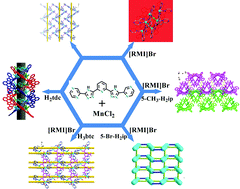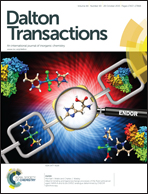Influence of ionic liquids on the syntheses and structures of Mn(ii) coordination polymers based on multidentate N-heterocyclic aromatic ligands and bridging carboxylate ligands†
Abstract
Seven Mn(II) coordination polymers, namely {[Mn2(ptptp)Cl2(H2O)3]·H2O}n (1), {[Mn(μ-ptptp)3]2[Mn3(μ3-Cl)]2}·2Cl·16H2O (2), {[Mn2(ptptp)(ip)2(H2O)3]·H2O}n (3), {[Mn2(ptptp)(5-CH3-ip)2(H2O)3]·H2O}n (4), {[Mn4(ptptp)(5-Br-ip)3(H2O)3]·4H2O}n (5), {[Mn2(ptptp)(Hbtc)(H2O)2]·2H2O}n (6) and {[Mn2(ptptp)(tdc)(H2O)2]·1.5H2O}n (7), have been prepared based on multidentate N-heterocyclic aromatic ligands and bridging carboxylate ligands (H2ptptp = 2-(5-{6-[5-(pyrazin-2-yl)-1H-1,2,4-triazol-3-yl]pyridin-2-yl}-1H-1,2,4-triazol-3-yl)pyrazine; R-isophthalic acids, H2ip-R: R = –H (3), –CH3 (4), –Br (5); H3btc = trimesic acid (6); H2tdc = thiophene-2,5-dicarboxylic acid (7)), in order to further probe the multiple roles of [RMI]Br ionic liquids in the hydro/solvothermal synthesis (RMI = 1-alkyl-3-methylimidazolium, R = ethyl, or propyl, or butyl). The successful syntheses of complexes 2–6 suggest that in hydro/solvothermal synthesis the addition of a small amount of [RMI]Br plays a crucial role. Complex 1 exhibits single right-handed helices constructed by ptptp ligands and Mn(II) ions. Complex 2 possesses octanuclear helicate structures in which two propeller-shaped [Mn(μ-ptptp)3]4− units embrace two [Mn3(μ3-Cl)]5+ cluster cores inside. Complexes 3 and 4 are isostructural and display a 1D double chain formed by two kinds of pseudo meso-helices: (Mn-ptptp)n and (Mn-5-R-ip)n. Complex 5 has a 2D structure containing 1D Mn(II) ion chains formed through carboxylates and [ptptp]2−-N,N bridges. Complex 6 shows a 2D structure formed by a meso-helix (Mn-ptptp)n and the partly deprotonated Hbtc ligands. Complex 7 features a heterochiral [2 + 2] coaxially nested double-helical column formed by using the outer double-helices (Mn-ptptp)n as a template to encapsulate the inner double-helices (Mn-tdc)n with opposite orientation. All complexes were characterized by elemental analysis, IR spectroscopy, thermogravimetric analysis, single-crystal X-ray crystallography and powder X-ray diffraction. The magnetic properties of 1–7 were also investigated.


 Please wait while we load your content...
Please wait while we load your content...